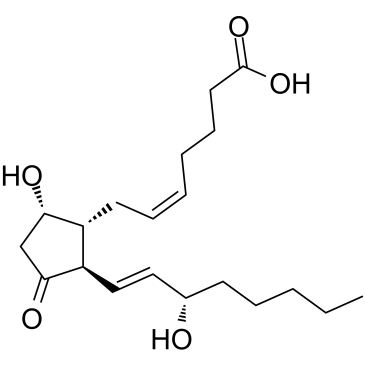Prostaglandin D2

Prostaglandin D2 structure
|
Common Name | Prostaglandin D2 | ||
|---|---|---|---|---|
| CAS Number | 41598-07-6 | Molecular Weight | 352.465 | |
| Density | 1.1±0.1 g/cm3 | Boiling Point | 549.6±50.0 °C at 760 mmHg | |
| Molecular Formula | C20H32O5 | Melting Point | N/A | |
| MSDS | Chinese USA | Flash Point | 300.3±26.6 °C | |
| Symbol |


GHS07, GHS08 |
Signal Word | Danger | |
|
HMDB: a knowledgebase for the human metabolome.
Nucleic Acids Res. 37(Database issue) , D603-10, (2009) The Human Metabolome Database (HMDB, http://www.hmdb.ca) is a richly annotated resource that is designed to address the broad needs of biochemists, clinical chemists, physicians, medical geneticists, nutritionists and members of the metabolomics community. Si... |
|
|
The human serum metabolome.
PLoS ONE 6(2) , e16957, (2011) Continuing improvements in analytical technology along with an increased interest in performing comprehensive, quantitative metabolic profiling, is leading to increased interest pressures within the metabolomics community to develop centralized metabolite ref... |
|
|
Malva sylvestris L. extract suppresses desferrioxamine-induced PGE₂ and PGD₂ release in differentiated U937 cells: the development and validation of an LC-MS/MS method for prostaglandin quantification.
Biomed. Chromatogr. 28(7) , 986-93, (2014) Malva sylvestris is a species used worldwide as an alternative to anti-inflammatory therapies; however, its mechanism of action remains unknown. In this paper, the anti-inflammatory effects of M. sylvestris alcoholic extracts were evaluated by measuring the p... |
|
|
Identification of prostamides, fatty acyl ethanolamines, and their biosynthetic precursors in rabbit cornea.
J. Lipid Res. 56 , 1419-33, (2015) Arachidonoyl ethanolamine (anandamide) and pros-taglandin ethanolamines (prostamides) are biologically active derivatives of arachidonic acid. Although available through different precursor phospholipids, there is considerable overlap between the biosynthetic... |
|
|
Biosynthesis and actions of 5-oxoeicosatetraenoic acid (5-oxo-ETE) on feline granulocytes.
Biochem. Pharmacol. 96 , 247-55, (2015) The 5-lipoxygenase product 5-oxo-6,8,11,14-eicosatetraenoic acid (5-oxo-ETE) is the most powerful human eosinophil chemoattractant among lipid mediators and could play a major pathophysiological role in eosinophilic diseases such as asthma. Its actions are me... |
|
|
Activation of the prostaglandin D2 metabolic pathway in Crohn's disease: involvement of the enteric nervous system.
BMC Gastroenterol. 15 , 112, (2015) Recent works provide evidence of the importance of the prostaglandin D2 (PGD2) metabolic pathway in inflammatory bowel diseases. We investigated the expression of PGD2 metabolic pathway actors in Crohn's disease (CD) and the ability of the enteric nervous sys... |
|
|
The cyclopentenone prostaglandin 15d-PGJ2 inhibits the NLRP1 and NLRP3 inflammasomes.
J. Immunol. 194(6) , 2776-85, (2015) Inflammasomes are cytosolic protein complexes that respond to diverse danger signals by activating caspase-1. The sensor components of the inflammasome, often proteins of the nucleotide-binding oligomerization domain-like receptor (NLR) family, detect stress,... |
|
|
Diagnostic use of cerebral and extracerebral oxysterols.
Clin. Chem. Lab Med. 42(2) , 186-91, (2004) 24S-Hydroxycholesterol (24OHC) and 27-hydroxycholesterol (27OHC) are two structurally similar oxysterols of different origins--the former almost exclusively formed in the brain and the latter formed to a lesser extent in the brain than in most other organs. H... |
|
|
Expression of DP2 (CRTh2), a prostaglandin D₂ receptor, in human mast cells.
PLoS ONE 9(9) , e108595, (2014) PGD₂ has long been implicated in allergic diseases. Recent cloning of a second PGD₂ receptor, DP2 (also known as CRTh2), led to a greater understanding of the physiological and pathophysiological implications of PGD₂. PGD₂ signaling through DP1 and DP2 mediat... |
|
|
Coordinate regulation between the nuclear receptor peroxisome proliferator-activated receptor-γ and cyclooxygenase-2 in renal epithelial cells.
Biochem. Pharmacol. 90(4) , 432-9, (2014) The peroxisome proliferator-activated receptors (PPARs) are ligand-dependent transcription factors involved in lipid metabolism and glucose utilization, in cell growth, differentiation and apoptosis, and in the regulation of pro-inflammatory genes expression ... |